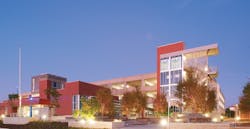Colleges and universities are among the most active players in the green building game, to the point where LEED Gold and even LEED Platinum are becoming de rigueur on campus. Recently, several academic institutions have moved to the head of the class with net-zero energy projects.
Take the new campus police substation at San Diego Miramar College, designed by Harley Ellis Devereaux. The 5,108-sf facility earned LEED Platinum and has been designed to net-zero energy readiness. That promise will be fulfilled when PVs are added to the adjacent four-story, 828-space parking garage (by International Parking Design. McCarthy Building Cos. was the GC on the entire $17.9 million complex.
A solar chimney in the substation tower creates an airflow that pulls cool ocean air through the interior. The HVAC system automatically shuts down when the operable windows are open. A terra cotta greenscreen and vegetated roof shield the building from solar heat gain.
At Georgia Tech, HDR Architecture and CUH2A teamed up with Gilbane Building Co. on the recently opened Carbon-Neutral Energy Solutions Laboratory. The $23 million facility is devoted to research in energy-conversion technologies, such as biomass gasification kinetics, high-efficiency combustion engines, biochemical-enzymatic conversion of biomass materials, and greenhouse gas capture from power plants.
The Building Team collaborated with Georgia Tech researchers to evaluate initial costs, life cycle costs, and carbon savings for numerous energy-saving options. Net-zero energy strategies include translucent wall panels to maximize daylight, operable windows, radiant heat, underfloor air distribution, and chilled beams. On the south façade, the glazing is shaded with an awning clad in PV panels; PVs were also installed on the roof and nearby on the site.
Meanwhile, LEED Platinum medallions keep piling up at universities. As controls subcontractor to Anderson Construction (GC), CH2M Hill aided in the design of Oregon State University’s Energy Center, the first power facility in the U.S. to win a Platinum rating. The 25,000-sf, 6.5MW co-generation plant is expected to reduce the university’s energy costs $650,000 a year and cut carbon emissions by 38% compared to the plant it replaced.
In the Chicago suburb of Palos Hills, Ill., Legat Architects completed Moraine Valley Community College’s Southwest Education Center, a slender, stand-alone off-campus facility that relies on a self-shading curtain wall to control heat buildup in summer. The HVAC system uses a geothermal system, with 36 geothermal wells, each 320 feet deep, and heat pumps to reduce energy consumption by 45% over a conventional design. It, too, has achieved LEED Platinum status.
LEED Platinum was recently earned by the Centre of Construction Excellence at Algonquin College, Ottawa, Ont. The $79 million, 200,000-sf research facility achieved a 60% reduction in energy consumption against the Model National Energy Code of Canada.
The Building Team included design firms Diamond Schmitt Architects and Edward J. Cuhaci and Associates Architects; Halsall (SE, green building consultant); and EllisDon Corporation (design-build contractor).
LEED Gold projects are also dotting the academic landscape. In Selden, N.Y., BBS Architects, Landscape Architects and Engineers (architect, interior designer, MEP), Tsoi/Kobus & Associates (lab designer), and Ysrael A. Seinuk (SE) designed the 68,500-sf Life Sciences Building at Suffolk County Community College for 1,500 students. Kiosks and interactive boards display real-time data on the building’s power and HVAC system performance.
In Massachusetts, Consigli Construction worked with the design team of Pfeufer Richardson Architects, Einhorn Yaffee Prescott, and Richard Burck Associates Landscape Architects to complete a 410-bed residence hall at Framingham State University. Ultra-high efficiency boilers, geothermal heat pumps, and a 20,000-gallon rainwater storage system helped gild the building.
At Tarrant County College’s Southeast Campus, in Arlington, Texas, SHW Group led the design of the 114,519-sf Science and Academic Building, specifying super-insulated walls and a highly efficient energy recovery mechanical system to trim energy use 21% below code.
The true measure of any green building, however, is how well it performs over time. The Multi-Use Building at City College of San Francisco, which went online in 2010, proved itself worthy of its LEED Gold designation by using 40% less energy than a building designed to code; this, despite record high temperatures in the summer of 2011 and record cold temps last December.
The Building Team of Interface Engineering (MEP), Pfau Long Architecture (design architect), VBN Architects (executive architect), and Lend Lease (GC) completed the 102,000-sf academic facility. +
